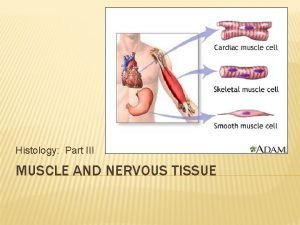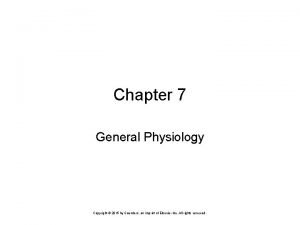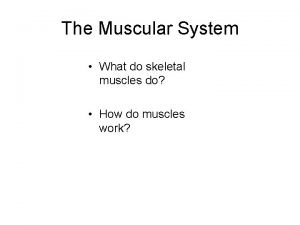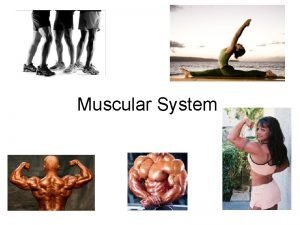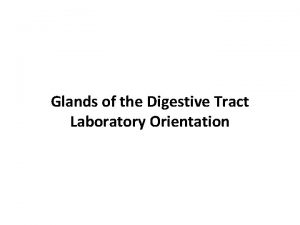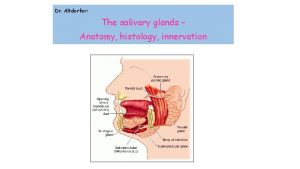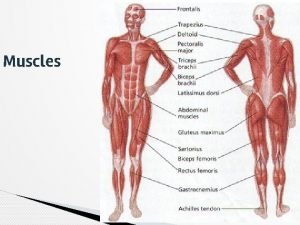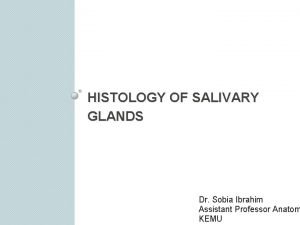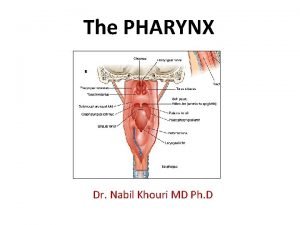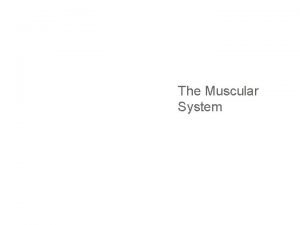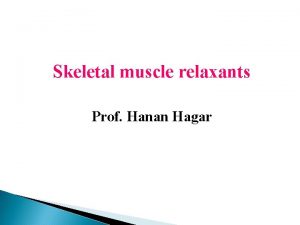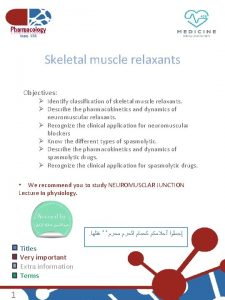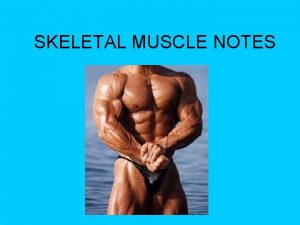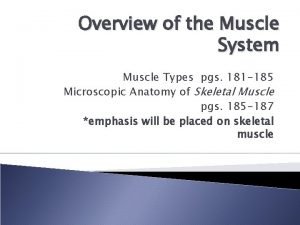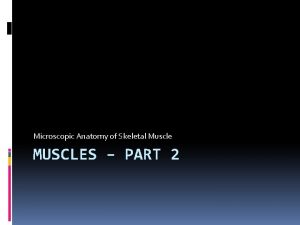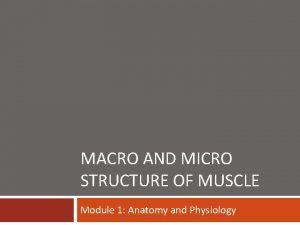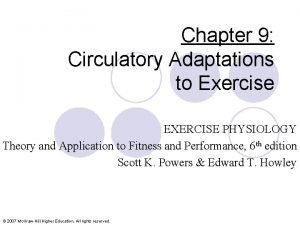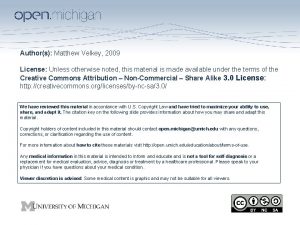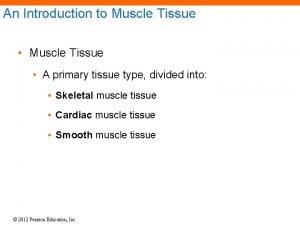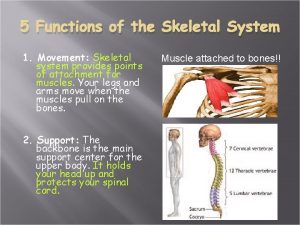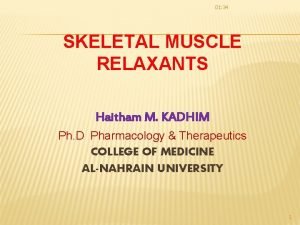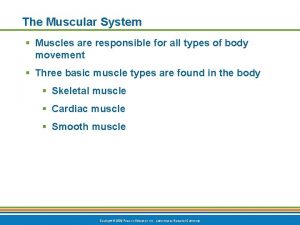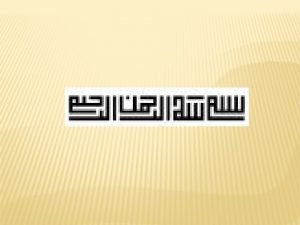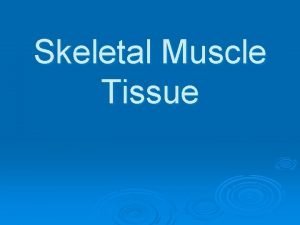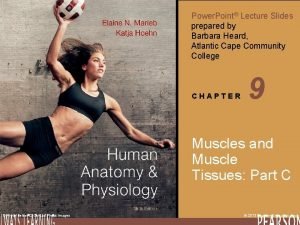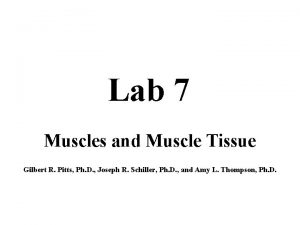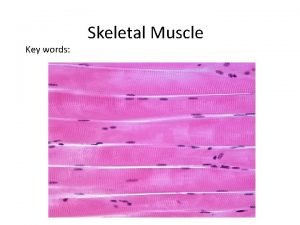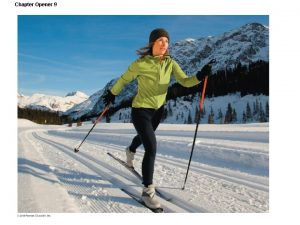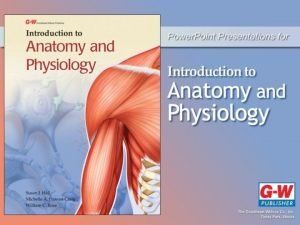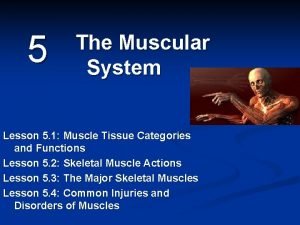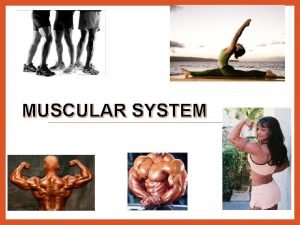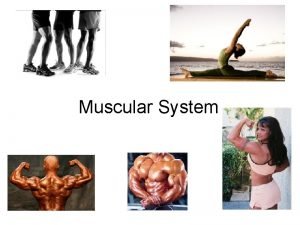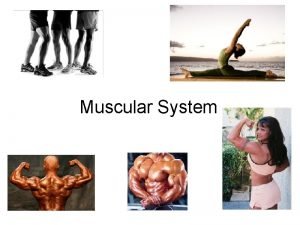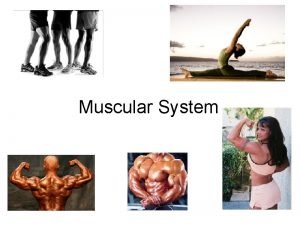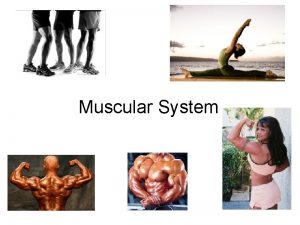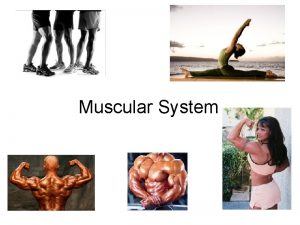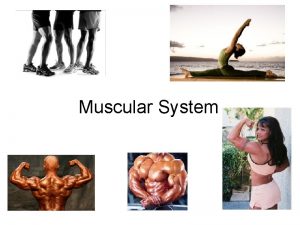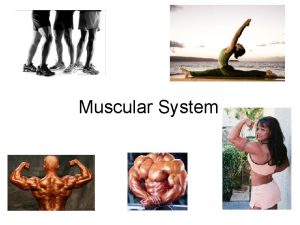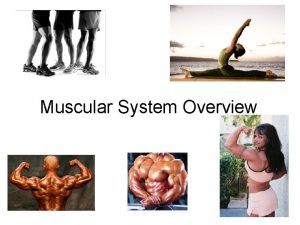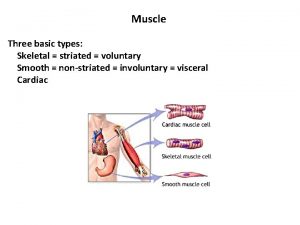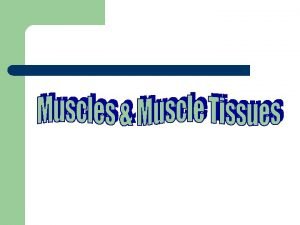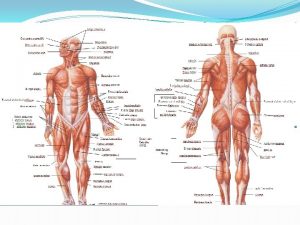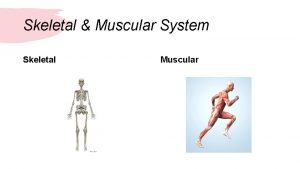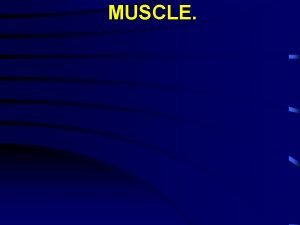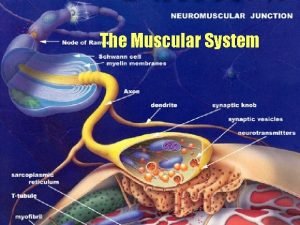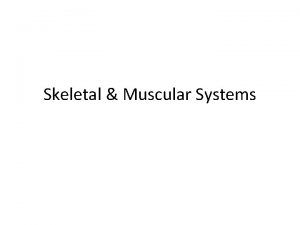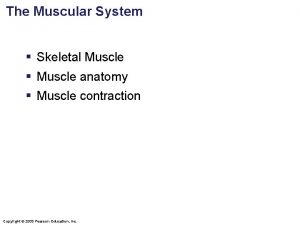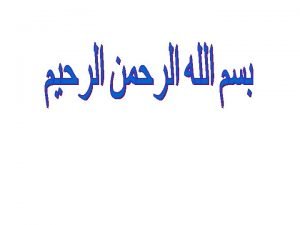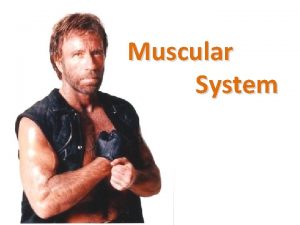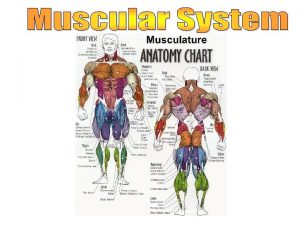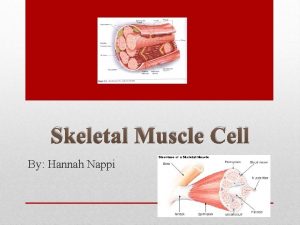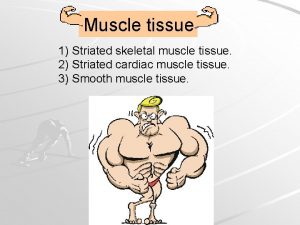Muscular System Types of Muscle Skeletal Striated Voluntary













































- Slides: 45

Muscular System


Types of Muscle Skeletal – Striated – Voluntary – Multinucleated n Smooth – Nonstriated – Involuntary n Cardiac – Striated – Involuntary – Intercalated disks n ~ 50% of body weight Work in groups to perform a function

General Functions of Muscular System n Movement – Skeletal muscle contractions move body in whole or part n Heat Production – Muscle cells produce heat via catabolism to maintain temperature homeostasis n Posture – Continued partial contraction of muscle in order to perform many functions

Characteristics of all Muscle n n Excitability – Respond to stimuli Contractility – Actively shorten to exert a pull – Tension that can be harnessed by CT Extensibility – Continue to contract over range of resting lengths – Ex: smooth muscle can be stretched to several times its original length and still contract on stimulation Elasticity – Return to original length after contraction

-mysium=CT membrane and tendon sheath

Muscle Fiber Arrangement Parallel Convergent Pennate Bipennate Sphincter

Muscle Attachment Does NOT move when muscle contracts hen w ove racts m t s Doe cle con mus

Naming Muscles n Location n Function n Shape n Fiber direction n Number of heads/divisions n Points of attachment n Muscle size

Location Function Frontalis Frontal bone Abductor Moves part away from body Femoris Femur Adductor Moves part toward body Gluteus Posterior of hip/thigh Depressor Lowers a part Oculi Eye Extensor Extends a part Oris Mouth Flexor Flexes a part Radialis Radius Levator Elevates a part Ulnaris Ulna Rotator Rotates a part Brachialis Arm Fiber Direction Shape Oblique Diagonal to midline Deltoid Shaped like delta ∆ Rectus Parallel to midline Orbicularis Circular Sphincter Circling an opening Platy Flattened; platelike Transversus Right angle to midline Quadratus Square Rhomboideus Diamond-shaped Trapezius Trapezoidal

Number of divisions Bicep Two heads Tricep Three heads Quadricep Four heads Size Brevis Short Longus Long Magnus Large Maximus Largest Medius Moderately sized Minimus Smaller

Raises eyebrows Frowning Mastication Blinking Laughing Whistling, smiling Puckering Mastication Flexes head

Moves head Flexes head

Superficial Back Muscles • Large, fan-shaped muscles provide force in a wide range of body positions -EX: leaning back to straight vertical and all points in between. Shrugging, pulling scapulas together and down Shoulder movement Pull the arm down, Stabilize torso during many movements (EX: bench press) Rotator cuff muscles Stabilize shoulder joint, pull arm back

Trunk Muscles - Thorax Elevate ribs

Trunk Muscles Abdomen Flexes trunk Compresses abdomen Stabilizes Lower back

Upper Arm Extends forearm Flexes Upper arm

Flexors

Extensors

Upper Leg Deep muscle Vastus intermedius Biceps femoris Quadricep Femoris Semimembranosus Semitendinosus

Lower Leg Plantar flexion

Foot

Classification of Muscle Group Actions Agonist (Prime Mover) – Muscle most responsible for movement n Antagonist – Opposes prime mover – Provides precision and control during prime mover contraction – Relaxes when prime mover contracts n Synergist – Aid prime mover – Contract at same time as prime mover n Fixator – Joint stabilizer – Maintains posture/balance during prime mover contraction n

Skeletal Muscle Structure (connective tissue components) n Endomysium – delicate membrane that covers muscle fibers n Perimysium – tougher tissue that binds muscle fibers together into fascicles. n Epimysium – a coarse sheath that covers the muscle as a whole. n Tendon – strong cord of fibrous tissue that binds muscle to bone.

Skeletal Muscle Structure (connective tissue components) n Aponeurosis – a broad flat sheet that merges with the wrappings of another muscle. n Fascia – fibrous connective tissue that surrounds the muscle outside the epimysium and tendon. n Tendon Sheaths – tube like structures that enclose certain tendons (wrist and ankle) and have a synovial lining that reduces friction.

-mysium=CT membrane and tendon sheath

Posture n Good Posture – body alignment that favors function with least work – Standing Position § § Head and chest held high Chin, abdomen, buttocks pulled in Knees slightly bent Feet firmly on ground 6 in. apart n Poor Posture - puts abnormal strain on ligaments and bones n Maintenance – Tonicity (muscle tone): muscles exert a pull against gravity § Continuous and passive partial contraction of muscles

Muscles & Age n Infancy & Childhood – Muscle coordination and control allows developmental sequences to occur n Aging – Muscles degenerate with age § Replaced with CT


Muscle cell (fiber) cytoplasm Basic contractile unit of muscle fiber H zone Space between actin Sarcoplasm Z line Muscle fiber membrane I band Z line A band Bundle of microfilaments; almost fill sarcoplasm Length of myosin heads (wide, dark stripes) Allows impulses to travel along sarcolemma deeper into muscle cell (fiber) Length of actin (thin, light stripes) Network of tubules and sacs: pumps calcium ions in from sarcoplasm to store in sacs Allows impulse traveling down T tubule to stimulate adjacent sacs


http: //highered. mcgrawhill. com/sites/0072495855/student_view 0/chapter 10/animation__sarcomere_c ontraction. html

Excitation & Contraction Impulse sent to muscle fiber Muscle fiber creates movement Synaptic cleft Motor endplate Synaptic vesicle Neuromuscular junction (neurotransmitter) http: //highered. mcgrawhill. com/sites/0072495855/student_view 0/chapter 10/animation__function_of_the_neuromuscular_junction __quiz_1_. html

Motor Unit Smaller # fibers – more precise movement Larger # fibers – more powerful contraction

SR releasing Ca+2 bind to troponin; Cross-bridging All or NONE • Quick jerk due to brief threshold stimulus • One twitch – 1/10 sec • Rarely occur • Gradual, step-like increase in contraction strength • Series of twitch contractions 1 sec apart • Muscle contracts more forcefully after it has contracted a few times, then when it first contracts • Warm-up before exercise • Smooth, sustained contractions • Coordinated contractions of different motor units • Multiple twitch waves add together to sustain muscle tension for longer time • Very short periods of relaxation between peaks of tension • Twitch waves fused into a single, sustained peak

Tonicity n Continual, partial contraction of a muscle n Flaccid – Muscles with less tone than normal n Spastic – Muscles with more tone than normal

Length-tension Relationship Optimal length Strongest max contraction possible Overstretched Sarcomere compressed Muscle can’t develop tension due to filaments too far apart

Energy Sources ATP – Hydrolysis into ADP yields energy required for contraction – ATP binds to myosin head in order to pull actin – Fibers continually resynthesize ATP from breaking down creatine phosphate (requires glucose and oxygen) n Glucose & oxygen – Hemoglobin transfers O 2 to muscle fiber – Fiber stores glucose as glycogen – At rest: Excess O 2 in sarcoplasm is bound to myoglobin temporarily – Exercise: O 2 concen. Decreases in muscle, so myoglobin resupplies muscle with O 2 n

Respiration n Aerobic Respiration n Anaerobic Respiration – Requires O 2 – Produces max amount of energy available from each glucose molecule – Occurs when lack of O 2 – Forms lactic acid § During exercise § Muscles “burn” – O 2 debt § Heavy breathing during exercise in order to process lactic acid

Muscle Fatigue n Muscles loses ability to contract due to lack of ATP n Lactic acid build up n Cramp – muscle contracts spasmodically, but does not relax completely

Most body movements are a result of both types

Change in Muscle Size n Atrophy – decrease in muscle size – Bed Rest: lose 1% muscle strength/day n Hypertrophy – increase in muscle size

Myopathies n n n Myalgia - muscle pain due to overstretching/tearing of muscle fibers Fibromyalgia – widespread muscle and CT pain Strain – caused by overexertion/trauma and can lead to muscle tear Myositis - any muscle inflammation Fibromyositis - tendon inflammation along with myositis Cramps – Painful muscle spasms – Due to mild myositis, fibromyositis, irritation, iron, and water imbalance – Charley Horse § Intense muscle spasms § Last few seconds to few hours § Caused by injury or overuse – Dehydration – Low K+ or Ca+2 – Nerve irritated § Treatment – Stop activity – Stretch and massage – Heat to relax muscle – Ice when spasm is over

Myopathies n Contusion n Poliomyelitis (Poilio) n Muscular Dystrophy n Myasthenia Gravis – Muscle bruise, local internal bleeding and inflammation – Crush injury: severe trauma to muscle, releasing fibers into bloodstream (life threatening) – – – Viral infection of nerves controlling skeletal movement Causes partial or full paralysis and death Vaccine created in US in 1950 s, but not everywhere – – – Genetic disease caused by muscle atrophy Some forms are fatal Most common form is Duchenne Muscular Dystrophy (DMD) – – Autoimmune disease that attacks muscle cells at NM junction Muscle weakness Can become a crisis and affect all four limbs Could die of respiratory failure

n Hernias – – – Myopathies “protrusion” Reducible – can manipulate protruding organ back into abdominal cavity Strangulated – blood flow to organ is stopped; obstruction, gangrene, pain. Vomiting, emergency surgery – Types § Inguinal – hernia extends into inguinal canal into scrotum or labia; affects more males § Femoral – affects more women below groin area due to pregnancy
 Which type of muscle is non-striated and involuntary
Which type of muscle is non-striated and involuntary Striated muscles
Striated muscles Which muscle is striated in appearance but resembles smooth
Which muscle is striated in appearance but resembles smooth Fusiform
Fusiform Skeletal and muscular system
Skeletal and muscular system Skeletal and muscular system
Skeletal and muscular system Imperfect voluntary act example
Imperfect voluntary act example Somatic nervous system
Somatic nervous system Striated muscles
Striated muscles Portal triad orientation
Portal triad orientation Nidus parotideus
Nidus parotideus Striated triceps
Striated triceps Serous glands
Serous glands Chapter 36 skeletal muscular and integumentary systems
Chapter 36 skeletal muscular and integumentary systems Chapter 14 skeletal muscular and nervous systems
Chapter 14 skeletal muscular and nervous systems Plyometrics disadvantages
Plyometrics disadvantages 4 muscles of pharynx
4 muscles of pharynx Label the superficial muscles
Label the superficial muscles Centrally acting skeletal muscle relaxants
Centrally acting skeletal muscle relaxants Skeletal muscle relaxants classification
Skeletal muscle relaxants classification Classification of skeletal muscle relaxant
Classification of skeletal muscle relaxant Chlorzoxone
Chlorzoxone Epi peri endo
Epi peri endo Sarcoplasmic
Sarcoplasmic Skeletal muscle relaxants classification
Skeletal muscle relaxants classification Characteristics of skeletal smooth and cardiac muscle
Characteristics of skeletal smooth and cardiac muscle Microscopic anatomy of skeletal muscles
Microscopic anatomy of skeletal muscles Micro and macro structure of skeletal muscle
Micro and macro structure of skeletal muscle Organization of the skeletal muscle
Organization of the skeletal muscle Skeletal muscle pump
Skeletal muscle pump Cardiac muscle cross section
Cardiac muscle cross section Motor end plates
Motor end plates What are the 5 functions of the skeletal system
What are the 5 functions of the skeletal system Skeletal muscle relaxants classification
Skeletal muscle relaxants classification Microscopic anatomy of skeletal muscle figure 6-2
Microscopic anatomy of skeletal muscle figure 6-2 Microscopic anatomy of skeletal muscle figure 6-2
Microscopic anatomy of skeletal muscle figure 6-2 Nerve supply skeletal muscle
Nerve supply skeletal muscle Skeletal muscle belly
Skeletal muscle belly Slide
Slide Label the superficial muscles
Label the superficial muscles Skeletal muscle cylindrical
Skeletal muscle cylindrical Skeletal muscle tissue description
Skeletal muscle tissue description Comparison of skeletal cardiac and smooth muscle
Comparison of skeletal cardiac and smooth muscle Lesson 5.1 the organization of a skeletal muscle
Lesson 5.1 the organization of a skeletal muscle Cross bridge cycle
Cross bridge cycle Lesson 5.1 the organization of a skeletal muscle
Lesson 5.1 the organization of a skeletal muscle

